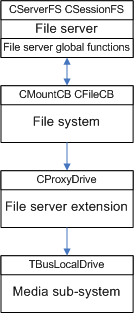File Server Extensions
This document provides an overview of the file server extension architecture, and of the APIs that allows file server extensions to be developed and used.
A file server extension is a library that allows the functionality of a file server logical drive and its corresponding file system to be extended or modified.
The Symbian platform uses a file server extension to implement its Flash Transition Layer (FTL) that allows a FAT file system to run on a NAND flash device. Because this layer is not needed when using FAT on a RAM disk or a MultiMediaCard, it is not necessary to add this functionality to the FAT file system itself. So the FTL is implemented as a file server extension and is only used on NAND local drives.
The file server uses libraries called file systems, which implement support for particular file system formats, such as FAT and LFFS. These file system libraries in turn make calls to the media sub-system, which provides device drivers that handles interaction with the actual storage hardware.
A file server extension is an additional layer that intercepts all calls from a file system to the media sub-system, as shown below:
All calls to the media sub-system from a mounted file system go through a "proxy" drive interface provided by the loaded extension (or extensions), before the call is passed on to the media sub-system interface.
An extension has the same lifetime as its corresponding file system object. This is usually a CMountCB object but can also be a subsession object (for example CFileCB). On removable drives, if a mount with an extension is destroyed when the media is removed, then when the same media is reinserted, the mount object and extension should be created at the same time.
Extensions can be referred to as being primary or secondary:
An extension is called primary if it is required for the file system to be used. Such extensions must be mounted before or at the same time as a file system is mounted on a drive. This can be done by modifying the initial mounting of the local file system in the Base Starter component. The file system mounted on the drive must be dismounted before a primary extension can be dismounted.
Only one primary extension is permitted to be mounted on a drive at a time.
Secondary extensions can be added after a file system is mounted. The maximum number of extensions allowed is two.
When two extensions are loaded, calls are passed through both extensions in turn. This is referred to as chaining. The order of chaining is determined by the order that extensions are mounted on the drive. The extension mounted first is closest to the media sub-system interface. Therefore the primary extension is always closest to the media sub-system interface.
Copyright ©2010 Nokia Corporation and/or its subsidiary(-ies).
All rights
reserved. Unless otherwise stated, these materials are provided under the terms of the Eclipse Public License
v1.0.
